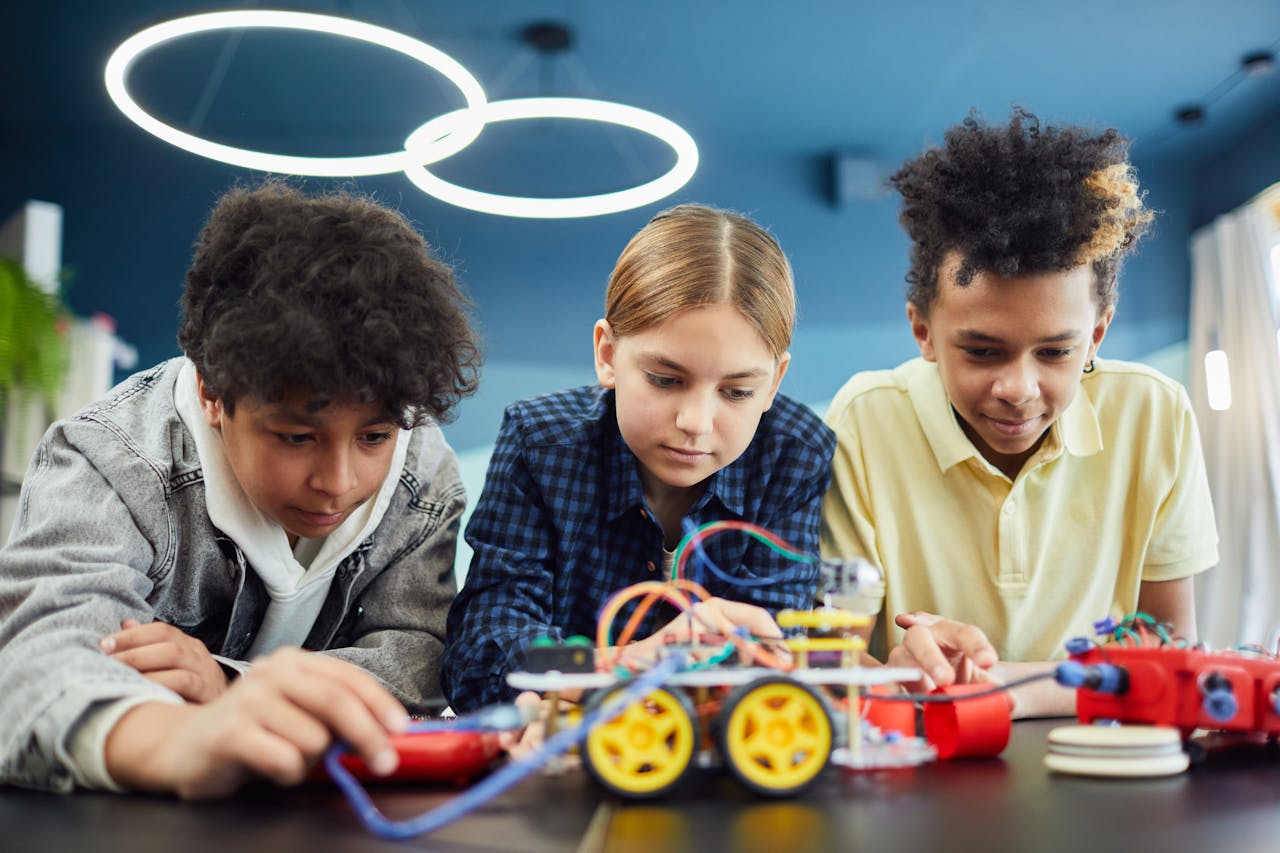In today’s digital age, technology has become an indispensable tool for educators, parents, and students, profoundly transforming how children learn and develop essential skills. Beyond traditional classrooms, technology offers innovative solutions that promote engagement, creativity, critical thinking, and personalized learning. This article explores the impact of technology on learning outcomes, with a focus on three areas: mobile apps and platforms that boost creativity and problem-solving skills, robotics and STEM-focused learning programs, and AI tutors and chatbots supporting real-time learning.
1. Mobile Apps and Platforms that Boost Creativity and Problem-Solving Skills
Mobile devices like tablets and smartphones have unlocked new opportunities for children to engage with interactive learning tools. Educational apps and platforms are designed to stimulate curiosity and help students develop essential life skills like creativity, problem-solving, collaboration, and critical thinking.
Creativity-Boosting Apps
Platforms such as Tynker, Scratch Junior, and Minecraft Education Edition introduce children to basic concepts of design, storytelling, and coding while encouraging creative thinking. For example, Minecraft encourages students to build virtual worlds, which not only requires imaginative thinking but also demands strategic planning, resource management, and collaboration with peers.
Problem-Solving Skills through Gamified Learning
Gamification integrates educational content into game formats, making learning both engaging and challenging. Apps like Prodigy and Kahoot! use gamified quizzes and missions to build problem-solving abilities in subjects like math and science. As children work through progressively difficult levels, they develop persistence and critical thinking. These platforms reward achievements, boosting motivation and fostering a sense of accomplishment.
Creative Expression through Arts and Language Platforms
Apps like Canva for Education and Book Creator encourage students to express their ideas visually and through storytelling. Canva enables students to create posters, infographics, and presentations, while Book Creator allows children to write and publish their own digital books. Platforms like Duolingo gamify language learning, where solving puzzles unlocks new lessons, helping children improve their language skills with minimal frustration.
Real-World Problem Solving with Design Challenges
Apps like Seesaw and Thingiverse Education allow students to participate in virtual design competitions and challenges that mimic real-world problems. By working on these projects, students develop practical problem-solving abilities and learn how to brainstorm and evaluate multiple solutions.
Through these mobile apps and platforms, children can engage in independent, exploratory learning that promotes both creativity and problem-solving — crucial skills for success in the 21st century.
2. Robotics, Coding, and STEM-Focused Online Learning Programs for Kids
Robotics, coding, and STEM (Science, Technology, Engineering, and Mathematics) programs are among the most significant advancements in modern education. These programs not only enhance technical knowledge but also nurture analytical thinking, creativity, and resilience. Early exposure to these areas helps students develop a mindset ready for future technological challenges.
Robotics and Hands-on Learning
Robotics kits like LEGO Mindstorms, VEX Robotics, and Sphero offer children hands-on experiences where they design, build, and program robots to complete tasks. These activities help develop a deep understanding of engineering principles, algorithms, and automation. Robotics fosters problem-solving as children troubleshoot issues with sensors, motors, or coding logic.
Coding Platforms That Spark Innovation
Coding has become an essential literacy skill, and platforms like Code.org, Scratch, and Tynker make it accessible to young learners. These tools introduce coding through visual blocks or simple scripting languages, gradually building up to more advanced programming skills. By learning to code, children develop computational thinking, an approach to solving problems through logical steps and pattern recognition.
STEM-Focused Online Learning Programs
Several online platforms provide structured STEM learning experiences tailored to different age groups. For example, Khan Academy offers free, high-quality tutorials in subjects like math, physics, and computer science. Similarly, Brilliant.org presents interactive STEM puzzles, fostering creative problem-solving. Programs like Outschool offer live, interactive classes where kids can learn robotics, physics, or chemistry through project-based learning.
Encouraging Innovation with Virtual Maker Spaces
Virtual maker spaces such as TinkerCAD or Make: Projects allow students to build 3D models, experiment with circuits, and develop prototypes of their designs. These platforms give children the opportunity to apply theoretical concepts in practical ways, reinforcing learning through experimentation.
Robotics and STEM programs are especially valuable for developing resilience, as children encounter and resolve failures along the way. This iterative process cultivates problem-solving skills and a growth mindset, preparing students for careers in technology-driven industries.
3. AI Tutors and Chatbots Supporting Real-Time Learning
Artificial intelligence (AI) is revolutionizing education by enabling real-time, personalized learning support for students. AI-driven tools like chatbots and virtual tutors complement traditional learning by providing tailored assistance that adapts to each student’s pace and understanding.
AI-Powered Personalized Learning
AI tools can analyze a student’s strengths and weaknesses, adapting lessons accordingly to address gaps in knowledge. Platforms such as Knewton and DreamBox Learning use AI algorithms to adjust the difficulty of tasks in real time, ensuring that students remain engaged without becoming overwhelmed. Similarly, tools like ALEKS (Assessment and Learning in Knowledge Spaces) continuously monitor a child’s learning progress and provide personalized recommendations.
Real-Time Support through AI Chatbots
AI chatbots like Quizlet’s Q-Chat and Duolingo Bots provide real-time feedback, explanations, and hints when students are stuck. These chatbots can answer common questions, guide children through lessons, and provide encouragement, making learning feel more interactive. For example, if a student struggles with a math problem, an AI tutor can break down the solution step by step, ensuring the student grasps the concept before moving forward.
Addressing Learning Gaps with Virtual Tutors
AI tutors, such as those provided by Socratic or Photomath, empower students to explore subjects independently. These tools allow children to scan questions or math problems and receive immediate explanations and solutions. With AI acting as a tutor, students can get help at any time, beyond the constraints of school hours or teacher availability.
Supporting Special Needs and Diverse Learners
AI tools also play a vital role in supporting children with diverse learning needs. Speech recognition software and text-to-speech programs help children with dyslexia or speech impairments. Platforms like KidSense.AI offer tailored learning paths that address the unique challenges of children with learning disabilities, ensuring that all students have equal access to quality education.
AI-powered tools also enhance student engagement by providing instant feedback and rewards, maintaining motivation throughout the learning process. In combination with teachers, AI chatbots and virtual tutors ensure that every child receives the right level of support, whenever they need it.
Conclusion
Technology is transforming education by creating more engaging, personalized, and effective learning experiences. Mobile apps and platforms nurture creativity and problem-solving through gamified content and design tools. Robotics, coding, and STEM-focused programs equip children with technical skills and critical thinking abilities essential for future careers. AI tutors and chatbots provide real-time, personalized support, helping children overcome challenges and maintain steady learning progress.
While technology cannot replace the role of teachers, it serves as a powerful tool to enhance educational outcomes. By integrating these innovative technologies into learning environments, educators and parents can better prepare children for the challenges of the future, fostering a generation of problem-solvers, innovators, and lifelong learners.



